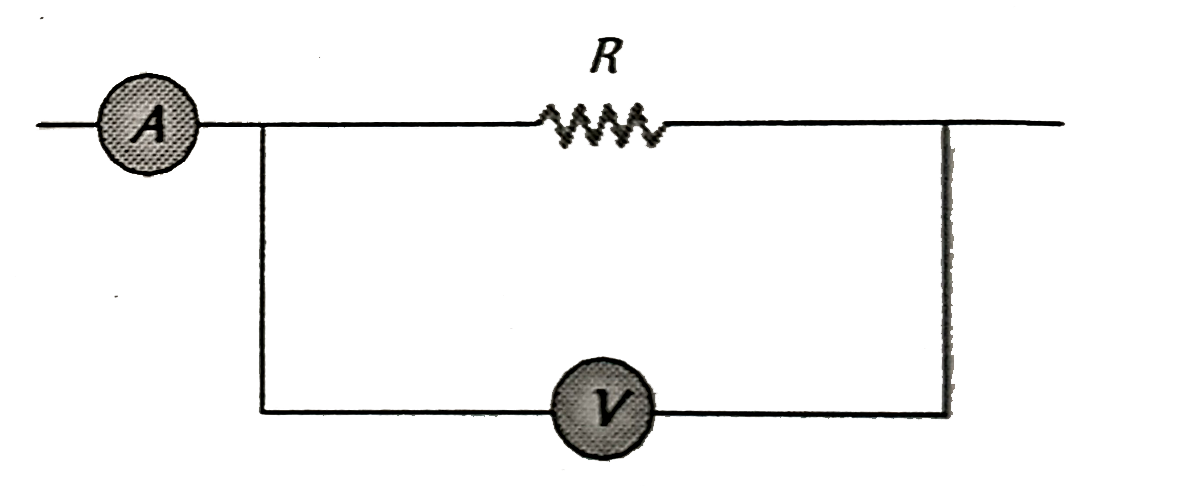In the given circuit diagram, a voltmeter 'V' is connected across a lamp 'L'. How would (i) the brightness of the lamp and (ii) voltmeter reading 'V' be affected, if the value of resistance 'R' is decreased ? Justify your answer.
To solve the question, we need to analyze the effect of decreasing the resistance R on both the brightness of the lamp L and the reading of the voltmeter V connected across the lamp.
1. Understand the Circuit:
- The circuit consists of a lamp L and a resistor R in series. The voltmeter V is connected in parallel with the lamp L.
- The brightness of the lamp is related to the current flowing through it, and the voltmeter reading indicates the voltage across the lamp.
2. Effect of Decreasing Resistance R:
- When the resistance R is decreased, according to Ohm's law (V=IR), the total current I in the circuit increases because the total resistance of the circuit decreases.
- This increase in current will lead to an increase in the current flowing through the lamp L.
3. Brightness of the Lamp:
- The brightness of a lamp is directly proportional to the power it dissipates, which can be expressed as P=I2RL (where RL is the resistance of the lamp).
- Since the current through the lamp increases due to the decrease in R, the power dissipated by the lamp also increases, making the lamp brighter.
4. Voltmeter Reading:
- The voltmeter V measures the voltage across the lamp L. As the current through the lamp increases, the voltage across it also increases (assuming the lamp has a constant resistance).
- Therefore, the reading on the voltmeter will also increase as the resistance R decreases.
5. Conclusion:
- (i) The brightness of the lamp will increase.
- (ii) The voltmeter reading V will also increase.
- The circuit consists of a lamp L and a resistor R in series. The voltmeter V is connected in parallel with the lamp L.
- The brightness of the lamp is related to the current flowing through it, and the voltmeter reading indicates the voltage across the lamp.
- When the resistance R is decreased, according to Ohm's law (V=IR), the total current I in the circuit increases because the total resistance of the circuit decreases.
- This increase in current will lead to an increase in the current flowing through the lamp L.
- The brightness of a lamp is directly proportional to the power it dissipates, which can be expressed as P=I2RL (where RL is the resistance of the lamp).
- Since the current through the lamp increases due to the decrease in R, the power dissipated by the lamp also increases, making the lamp brighter.
- The voltmeter V measures the voltage across the lamp L. As the current through the lamp increases, the voltage across it also increases (assuming the lamp has a constant resistance).
- Therefore, the reading on the voltmeter will also increase as the resistance R decreases.
- (i) The brightness of the lamp will increase.
- (ii) The voltmeter reading V will also increase.
Topper's Solved these Questions
- XII BOARDSBOOK - XII BOARD PREVIOUS YEAR PAPER ENGLISHCHAPTER - XII BOARDSEXERCISE - SET - II (Delhi Board)
7 Videos
- XII BOARDSBOOK - XII BOARD PREVIOUS YEAR PAPER ENGLISHCHAPTER - XII BOARDSEXERCISE - SET - III (Delhi Board)
6 Videos
- XII BOARDSBOOK - XII BOARD PREVIOUS YEAR PAPER ENGLISHCHAPTER - XII BOARDSEXERCISE - PHYSICS (Theory) [SET - III]
9 Videos
- SAMPLE PAPER 2019BOOK - XII BOARD PREVIOUS YEAR PAPER ENGLISHCHAPTER - SAMPLE PAPER 2019EXERCISE - SECTION D
6 Videos
Similar Questions
In the following circuit, a voltmeter V is connected across a lamp L. What change would occure in voltmeter reading if the resistance R is reduced in value?

View SolutionIn the circuit, a voltmeter reads 30V when it is connected across 400 Ω resistance. Calculate what the same voltmeter will read when it is connected across the 300Ω resistance?

View SolutionIn the circuit shown alongside, the ammeter and the voltmeter redings are 3A and 6V, respectively. Then, the value of the resistance R is

View SolutionAn ammeter A, a voltmeter V and a resistance R are connected as shown in the figure. If the voltmeter reading is 1.6V and the ammeter reading is 0.4A, then R is

View SolutionAn ammeter and a voltmeter are connected in series to an ideal battery of emf E. If the ammeter reads I and voltmeter reading V, then
View SolutionThe ammeter A reads 2A and the voltmeter V reads 20V, the value of resistance R is (Assuming finite resistance's of ammeter and voltmeter)

View SolutionIn the circuit figure, the voltmeter reads 30 V. The resistance of the voltmeter is

View SolutionIn the given circuit, the voltmeter records 5 V. The resistance of the voltmeter in Ω is

View SolutionConsider the following circuit :

What would be the readings of the ammeter and the voltmeter when key is closed ? Give reason to justify your answers .
View SolutionThe voltmeter shown in figure reads 18V across the 50(Ω)resistor. Find the resistance of the voltmeter.

View Solution
